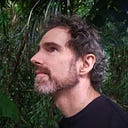Towards Subtraction
Transcending Net-Zero to Net-Green
Observe the way the Earth subtracts more of its carbon into cycling and sequestration than it adds back to the biosphere. — Earthen ethic №4
58 MILLION YEARS AGO the Earth entered the Carboniferous period with an atmosphere full of CO2. At the outset of the age, plants had just evolved leaves and stalks. 50 million years later, not only did vast leafy forests cover the planet, the Earth’s atmospheric carbon had been reduced 10 fold.
Early in the period, plants had just figured out how to make lingin cells; the sturdy cellulose required to build bark and trunks. Meanwhile, fungi had yet to devise a means for its quick decomposition. When a tree fell, before it could be decomposed and its carbon released, other fallen trees and vegetation would cover it up. Entombed with no oxygen or sunlight reaching it, bacteria and fungi, could not break it down. Compacted by more and more fallen forest, the tree’s carbon was effectively secured into geological storage — along with countless others like it. As unprecedented amounts of biomass were sequestered from the atmosphere, the climate stabilized, oxygen levels soared…
